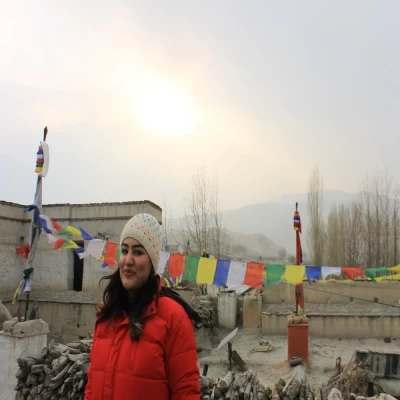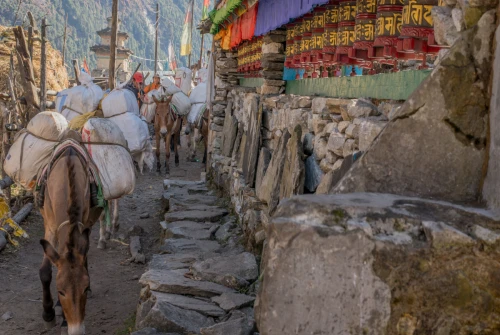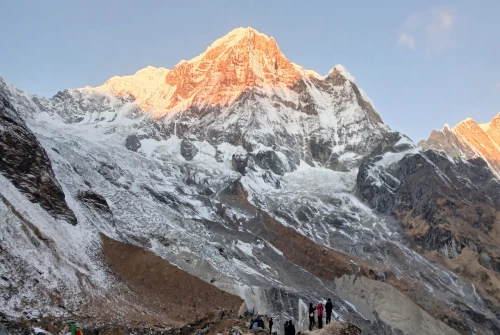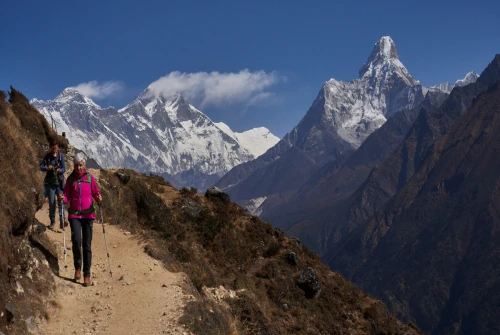Annapurna Circuit Trek stands as one of the most legendary trekking routes in the world and for good reason. It takes us through a breathtaking transition of landscapes, cultures, and altitudes over two to three weeks. From tropical river valleys and terraced farmlands to arid alpine deserts and the dramatic snow-laden heights of Thorong La Pass, every step along this journey is an immersion in nature’s grandeur and Nepal’s rich ethnic diversity.
But one of the most important questions every trekker asks is: “When is the best time for the Annapurna Circuit trek?” The answer is not one-size-fits-all; it depends on what we want from the experience. The trail transforms dramatically with each season. Spring wraps the hills in rhododendron blooms and offers warm, pleasant hiking weather. Autumn gifts us with the clearest mountain views and vibrant village life during Nepal’s grandest festivals. Winter strips the region down to its quiet, snow-covered bones, serene, cold, and silent. And monsoon, although often avoided, reveals a lusher, wetter version of the trail, filled with thunderous waterfalls and blooming rice terraces.
As we trek this circuit, whether we're soaking in the sunrise over Pisang Peak, crossing the windswept Thorong La pass, or enjoying a cup of tea with locals in Manang, our experience will be shaped by the season we choose. That’s why understanding each season’s offerings and challenges is crucial. Whether you're an experienced hiker planning for winter solitude or a first-time visitor aiming for perfect skies in October, choosing the Annapurna Circuit best season for the Annapurna Circuit is key to unlocking its true magic.
Despite modern roads encroaching upon the route, the Annapurna Circuit is still worth it, especially if we take higher trails and less-traveled paths. With the right timing and preparation, this trek delivers everything a mountain journey should: soaring peaks, ancient monasteries, dramatic landscapes, and the ever-welcoming spirit of the Himalayas.
Spring (March to May): Flowers, Fresh Trails, and Gradual Warmth
Spring is one of the best times to hike the Annapurna Circuit Trek, offering a balance of stable weather, blossoming nature, and increasingly warmer days. The trail begins to wake from winter. As we start from Besisahar or Dharapani, the air feels crisp but not cold, and colorful rhododendrons bloom across the forests from Tal to Ghorepani. Fields are green, the sky in the morning is mostly clear, and the trail feels alive with bird songs and fresh mountain air.
By the time we reach Manang (3,500m), daytime temperatures hover around 10°C to 15°C, while nights may still drop to -5°C. Higher up, toward Thorong La, temperatures range from -8°C to -15°C, especially in the early mornings. The snow from winter gradually melts, making the pass increasingly more navigable by mid-April. The route remains traditional, starting from lowland rice fields, ascending to pine forests, then to barren high-altitude desert around Yak Kharka and Thorong Phedi.
Pros: Blooming forests, active trails without overwhelming crowds, good visibility until May
Cons: Some lingering snow on high passes in early March, occasional haze by late spring
Verdict: Perfect for trekkers who want nature at its most colorful, moderate cold, and fewer crowds compared to autumn
Autumn (Late September to November): Perfect Weather and Crystal Views
Autumn is the most popular and best season for the Annapurna Circuit trek. After the summer monsoon washes away dust and haze, the skies become crystal clear, and the mountain views are nothing short of majestic. The days are sunny and dry, ideal for long trekking hours, while the fields glow gold with ripe crops, especially around Chame, Pisang, and Braka.
Temperatures at lower elevations (Besisahar to Chame) stay between 15°C to 20°C during the day and 5°C to 10°C at night. In Manang, days are around 10°C to 14°C and nights drop to -2°C to -5°C. At Thorong La, expect freezing mornings with temperatures around -10°C. Despite the chill, the weather is mostly stable with minimal snow on the pass.
We often walk under deep blue skies with uninterrupted views of Annapurna II, Gangapurna, Tilicho Peak, and Dhaulagiri. Local festivals like Dashain and Tihar also take place, offering cultural depth to the trek. Lodges are fully operational, but many fill quickly early booking is a must.
Pros: Best weather for mountain views, dry trails, vibrant cultural atmosphere
Cons: Crowded teahouses, busier trails, potential accommodation shortage
Verdict: Ideal for photographers, first-timers, and anyone who wants the Annapurna Circuit at its very best
Winter (December to February): Silent Beauty and Harsh Conditions
Winter transforms the Annapurna region into a snow-covered dreamscape. It’s quiet, surreal, and deeply peaceful. If you're seeking solitude and don’t mind the cold, this is a magical time to trek the Annapurna Circuit. From Dharapani to Pisang, snow begins to appear in patches by late December. By the time we reach Manang, the villages feel like sleepy hamlets surrounded by snow-draped cliffs.
Temperatures plummet. Manang drops to -10°C to -15°C at night, and Thorong La can reach -20°C or lower with wind chill. During the day, however, lower elevations still enjoy sunshine with 8°C to 12°C. The trail beyond Yak Kharka can be covered in deep snow, and crossing Thorong La requires caution, proper equipment (crampons, winter boots), and sometimes even a guide.
Many teahouses above Manang shut down or offer minimal services. It’s essential to carry proper winter gear and prepare for limited food and warmth at higher altitudes.
Pros: Peaceful, uncrowded trails, beautiful snow-covered vistas
Cons: Extreme cold, snow-blocked passes, limited accommodation, and resources
Verdict: Only suitable for experienced, well-equipped trekkers. Not recommended for beginners or those unfamiliar with high-altitude winter trekking
Monsoon (June to Mid-September): Wild Greens and Risky Trails
Monsoon is the least popular yet not entirely off-limits season for the Annapurna Circuit. Rain dominates the lower regions from Besisahar to Chame, turning trails slippery and obscuring views. Landslides are common, and swollen rivers can make bridges risky or impassable at times. Leeches thrive in the forested lower zones, especially between Syange and Dharapani.
Daytime temperatures in lower elevations hover around 20°C to 25°C with high humidity, and nights stay above 10°C. Manang and Upper Pisang, lying in the rain-shadow area, receive significantly less rainfall, making it possible to continue the trek with more favorable conditions after Chame. Mountain views are fleeting, mostly appearing in early mornings when clouds briefly clear.
Because of the risks, many trekkers avoid monsoon altogether, but if you're planning your trek with the best Annapurna trekking companies, they can guide you along safer sections like Upper Mustang or Nar-Phu Valley.
Pros: Lush scenery, less crowded, unique greenery, and waterfalls
Cons: Rain, leeches, landslides, obscured views, transportation delays
Verdict: Only recommended for adventurous trekkers who plan to stay in rain-shadow areas and accept the unpredictability of the season
Annapurna Circuit Trek: Seasonal Comparison Table
Season | Temperature Range | Weather Conditions | Trail & Route Notes | Best For |
Spring | 15°C to -10°C (lower to high altitude) | Clear mornings, blooming flora, warmer afternoons | Trails are dry and lively, with moderate snow at Thorong La | Nature lovers, moderate hikers, photographers |
Autumn | 20°C to -10°C | Crisp skies, low rainfall, excellent visibility | Perfect trail conditions, vibrant villages | First-time trekkers, cultural seekers, peak experience |
Winter | 10°C to -20°C | Very cold, snow in higher regions, dry lower areas | Snow-bound trails above Manang, some closures | Experienced trekkers, solitude seekers |
Monsoon | 25°C to 10°C | Wet, humid, frequent rain, landslides possible | Muddy trails, limited visibility, clearer in Mustang | Off-season adventurers, Mustang/Nar-Phu trekkers |
Is Annapurna Circuit Still Worth It?
Without a doubt, the Annapurna Circuit is still worth it, even in 2025. While motorable roads have shortened the traditional route, they’ve also made it more accessible. With smart detours and high trails (like Upper Pisang, Tilicho Lake, and Ngawal), we can still experience the raw, untouched beauty of the Himalayas. Pair this with the right season, and you unlock the very best of what Nepal has to offer.
From the lush valleys of Lamjung to the icy summit of Thorong La, and down into the windswept deserts of Muktinath and Jomsom, every season offers a new personality to this ancient path. Whether you're trekking in spring’s floral bloom or autumn’s golden harvest, the circuit gives you something deeply unforgettable.
FAQs related to Annapurna Circuit trek weather, timing, and route conditions.
1. What is the best time for the Annapurna Circuit trek for clear mountain views?
The best time to hike the Annapurna Circuit for clear views is during autumn (late September to November). During this period, the skies are crystal clear, the air is dry, and visibility is at its peak. Spring (March to April) also offers excellent views, especially in the mornings, though there can be slight haze by late April and May.
2. Is Thorong La Pass open all year round?
No, Thorong La Pass is not always accessible year-round. It is typically closed or extremely difficult to cross in winter (December to February) due to heavy snowfall and dangerous icy conditions. The pass is usually open and safest to cross in spring and autumn, when snow has melted and the weather is more stable.
3. Can I trek the Annapurna Circuit during monsoon season?
Yes, but with caution. Monsoon (June to mid-September) brings heavy rain, slippery trails, landslides, and poor visibility, especially from Besisahar to Chame. However, the Manang and Mustang regions, lying in the rain-shadow zone, receive less rainfall and remain trek-friendly. Choose Upper Pisang or Tilicho Lake routes to avoid muddy trails and leech-infested forests.
4. How cold does it get on the Annapurna Circuit?
Temperatures vary drastically based on altitude and season. In winter, temperatures can drop to -20°C at Thorong La and -10°C in Manang. In spring and autumn, high-altitude nights still dip below freezing, while daytime temperatures at lower elevations can be a pleasant 15°C to 20°C. Proper cold-weather gear is essential for higher sections year-round.
5. Are any sections of the route closed in winter?
Yes. In deep winter, parts of the trail between Yak Kharka and Thorong Phedi, as well as Thorong La Pass, can be blocked by snow. While lower sections of the trek remain open, many teahouses above Manang shut down or operate minimally. Trekkers must be prepared for fewer services and increased risk due to ice and snow.
6. Which season offers the safest trail conditions?
The safest trail conditions are typically found in autumn (October–November). The weather is dry, the trails are solid, and river crossings are manageable. Spring is also safe, though the trails can get dusty by late season. Monsoon and winter bring increased hazards, from landslides and slippery paths to snow-covered, impassable high passes.




